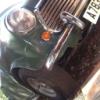
Fuel Gauge
Started by
James_1
, Apr 18 2007 08:59 PM
5 replies to this topic
#1

Posted 18 April 2007 - 08:59 PM
I am making a custom dash and I need a stand alone type fule gauge. I have heard that all Smiths fuel gauges are interchangeable. Is this true? Were there any cars fitted with Smiths fuel gauges as standard. I found this one on eBay which looks good but I'm not bidding unless someone can confirm that it will work without a new sender!

#2

Posted 19 April 2007 - 03:35 AM
For 90% of the applications the statement that all the fuel gauges are the same is pretty well true... AFTER 1964.
Examine the back of the gauge looking for two little holes (possibly covered with tiny cork disks). Below any cover disks should be what look like small screwdriver slots. Those gauges are the slow-response bimetallic gauges and they typically work through the range of 230 ohms empty to about 30 ohms full. Those gauges will work with the Mini sending unit.
Pre-1965 gauges typically didn't use the voltage stabilizer. They were fast responding and worked on the range of 0 ohms empty to 90 ohms full. When you look on the back of those gauges you won't find the screwdriver slots. What you'll see are two little brass posts that when loosened can slide in slots on the back of the gauge case. Those gauges also have needles that will bounce all over the place when you handle the gauge. Those pre-1965 gauges will only work with the 0-90 ohm "bolt on" sender used on the early Minis. Later 230-30 ohm senders mounted on the tank with a bayonet type locking ring.
The short answer though is that the picture you posted is of a later type gauge that should work with the Mini's sender if you're using a post-1965 fuel tank.
Examine the back of the gauge looking for two little holes (possibly covered with tiny cork disks). Below any cover disks should be what look like small screwdriver slots. Those gauges are the slow-response bimetallic gauges and they typically work through the range of 230 ohms empty to about 30 ohms full. Those gauges will work with the Mini sending unit.
Pre-1965 gauges typically didn't use the voltage stabilizer. They were fast responding and worked on the range of 0 ohms empty to 90 ohms full. When you look on the back of those gauges you won't find the screwdriver slots. What you'll see are two little brass posts that when loosened can slide in slots on the back of the gauge case. Those gauges also have needles that will bounce all over the place when you handle the gauge. Those pre-1965 gauges will only work with the 0-90 ohm "bolt on" sender used on the early Minis. Later 230-30 ohm senders mounted on the tank with a bayonet type locking ring.
The short answer though is that the picture you posted is of a later type gauge that should work with the Mini's sender if you're using a post-1965 fuel tank.
#3

Posted 19 April 2007 - 06:40 PM
Thanks very much for that. When you say that after '65 all fuel gauges are the same is this only Smiths or all manufactures?
#4

Posted 20 April 2007 - 03:21 AM
Around the world there were and are several "standard" ranges for fuel sending units and their matching gauges. My comments about the 230-30 Ohm range apply to virtually all of the Smiths and (British) Jaeger gauges of the late 1960s through at least the early 1980s. This would apply to any of the gauges in BMC/BL/Rover vehicles including Triumph, MG, and the Mini.
#5

Posted 27 April 2007 - 08:35 PM
I'v just won an XJ6 fuel gauge, I guess that being BL it will be fine?
http://cgi.ebay.co.u...:B:EOIBSA:UK:11
http://cgi.ebay.co.u...:B:EOIBSA:UK:11
Edited by James_1, 27 April 2007 - 08:35 PM.
#6

Posted 28 April 2007 - 03:17 AM
That gauge should be OK. To confirm that it's OK after you receive the gauge, connect it temporarily to your car's wiring where your existing gauge is. With the ignition on, reach through the tank's filler neck with a stiff wire or coat hanger. Lift the float arm to the top of it's travel to confirm the gauge shows full. Then push the arm down to the bottom to confirm empty is displayed on the gauge.
On many of the mid-1970s gauges Smiths coated the bezel with black paint as in the gauge you won. If you like black bezels, that's great. I've found that a little chemical paint remover and chrome polish can remove the black paint and reveal a nice chrome plating. However, be warned, I've seen some Smiths gauges for Triumphs that were not black paint over chrome, they were just black paint over mild steel. No harm done if you remove the paint and find plain steel. Just re-paint black again.
On many of the mid-1970s gauges Smiths coated the bezel with black paint as in the gauge you won. If you like black bezels, that's great. I've found that a little chemical paint remover and chrome polish can remove the black paint and reveal a nice chrome plating. However, be warned, I've seen some Smiths gauges for Triumphs that were not black paint over chrome, they were just black paint over mild steel. No harm done if you remove the paint and find plain steel. Just re-paint black again.
1 user(s) are reading this topic
0 members, 1 guests, 0 anonymous users














